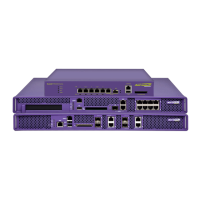Diagnostics
Summit WM3000 Series Controller System Reference Guide468
4 Click the Transfer Files button to open the transfer dialogue to enable a file to be copied to another
location. For more information on transferring core snapshots, see
“Transferring Core Snapshots” on page 468.
Transferring Core Snapshots
Use the Tran sf er screen to define a source for transferring core snapshot files to a secure location for
potential archive.
To transfer core snapshots to a user defined location:
1 Select Diagnostics > Core Snapshots from the main menu tree.
2 Select a target file, and select the Transfer Files button.
3 Use the From drop-down menu to specify the location from which the log file is sent.
If only the applet is available as a transfer location, use the default controller option.
4 Select a target file for the file transfer from the File drop-down menu.
The drop-down menu contains the core files listed within the File-Mgmt screen.
5 Use the To drop-down menu (within the Target field) to define whether the target log file is to be
sent to the system's local disk (Local Disk) or to an external server (Server).
6 Provide the name of the file to be transferred to the location specified within the File field.
7 If Server has been selected as the source, use the Using drop down-menu to configure whether the
log file transfer is sent using FTP or TFTP.
8 If Server has been selected as the source, enter the IP Address of destination server or system
receiving the target log file.
9 If Server has been selected as the source, enter the User ID credentials required to send the file to the
target location. Use the user ID for FTP transfers only.
10 If Server has been selected as the source, enter the Password required to send the file to the target
location using FTP.
11 Specify the appropriate Path to the target directory on the local system disk or server as configured
using the To parameter. If the local disk option is selected, use the browse button to specify the
location on the local disk.
12 Refer to the Status field for the current state of the requests made from applet. This field displays
error messages if something goes wrong in the transaction between the applet and the controller.
13 Click the Transfer button when ready to move the target file to the specified location. Repeat the
process as necessary to move each desired log file to the specified location.
14 If a problem condition is discovered during the file transfer, click the Abort button to terminate the
transfer.
15 Click the Close button to exit the screen after a transfer. There are no changes to save or apply.
Reviewing Panic Snapshots
Refer to the Panic Snapshots screen for an overview of the panic files available. Typically, panic files refer
to controller events interpreted as critical conditions (and thus requiring prompt attention). Use the
information displayed within the screen to make informed decisions whether a target file should be
discarded or transferred to a secure location for permanent archive.

